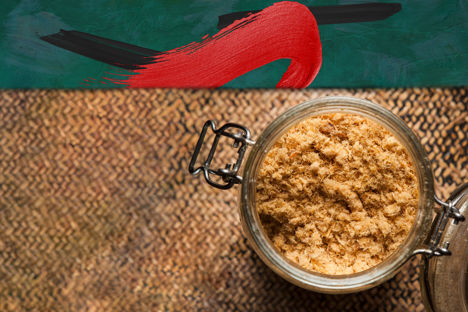
Painting a picture: ribs with pickled grapes and pork floss
The Silk Road is the name given to the famous trade routes that connected the East with the West, resulting in a transfer of not just commodities but cultures, people and food. Mukta Das and Andrew Wong talk about how traders survived in the desert during their journeys, before creating a recipe that represents both the trek and the hospitality of the Han emperor.
Painting a picture: ribs with pickled grapes and pork floss
The Silk Road is the name given to the famous trade routes that connected the East with the West, resulting in a transfer of not just commodities but cultures, people and food. Mukta Das and Andrew Wong talk about how traders survived in the desert during their journeys, before creating a recipe that represents both the trek and the hospitality of the Han emperor.
It was no easy life for the average trader on The Silk Road. The incredibly long journeys saw them work their way through the desert, stopping off at small garrison towns built around oases to rest and recuperate. Knowing that envoys who eventually arrived in China had been on the road for weeks, the Han emperor ordered grapes to be planted in his summer gardens so the traders could be offered grape wine when they arrived; a taste of their home. Food anthropologist Mukta Das and Michelin-starred chef Andrew Wong take a look at how these travellers ate and drank during their voyages, before creating a recipe that represents both the dryness of the desert and the hospitality of the Chinese hosts.
Sima Qian, Records of the Grand Historian: Han Dynasty, vol II, translated from Chinese by B. Watson. 1961 New York: Columbia Press. p 245.
Andrew Wong: I love the scene described above by this grand Chinese historian of the Han emperor, where grape vines were planted in the summer palace gardens as a welcome to Persian and other trade envoys. These people came to China from Persia and the other great empires of the West to trade spices and other luxury goods for silks and other commodities. They would stop for a while to feast and drink, which in turn created this culture of growing and drinking grape wine. I wanted to come up with a dish based on this idea of people traveling through the desert, getting to this point and having this moment where they are welcomed with wine – something they know from home. It's as close to China meeting Central Asia as you're going to get, and that is the importance of it. Chinese wine was traditionally made with grain, so importing grapes and actually learning how to grow and make grape wine shows how open China was to new ideas about food and drink.
Mukta Das: The poetry of the Tang and in later eras celebrates grape wine as a very elite and refined drink. What bedazzled these drinkers was the translucence of the wine; that light could shine through it. Poems and essays describe how essential it was to drink this rare liquid out of equally rare glasses, rather than the porcelain cups normally used to serve the more opaque, cloudy grain wines.
The trade envoys Andrew is talking about would have travelled along The Silk Road, a famous route shrouded in myth which linked Eastern Europe and Central Asia to China. In truth, there was no single ‘road’, and silk was one of many commodities traded on it; for many centuries, it was horses that were in hot demand. The Silk Road is a name invented in 1887 by a German cartographer opting for grandeur and romanticism.
In lieu of an actual road or well-defined path, Europeans, Central Asians and Chinese people who traded horses, silk, spices and chemicals with imperial China moved from garrison town to garrison town, all located in desert oases, taking whatever routes that their local guides advised. By the Tang Dynasty, the Chinese Imperial army were pretty much in control of most of the route which was no mean feat, as they were stationed in garrison towns and most of the time they were farmer-soldiers. They had a bit of irrigation know-how, so they were creating these oases as well as encountering natural ones. So as well as receiving rations from the central government they also started growing their own food, in order to feed themselves and any trader and entourage that came in to town bearing the right credentials. In every garrison town traders would have these slips, which they’d hand over to get food, lodgings, new horses and refreshments.
AW: Over time, of course, these oasis towns were swallowed up by the desert. What’s been fascinating for me is to look at the remains of food that have been long buried under the desert sand and then unearthed by some plucky archaeologists. These remains are desiccated – there’s no moisture in them, which is why they’ve been preserved so well, but when you look at photos, they’ve held their shape and their colour and they still look edible. There’s one photo of a row of kebab-like meat skewers, which is a very Central Asian dish. In another, there’s a small bowl of dumplings just missing their dipping sauce. So it makes me think that Chinese chef-solider-farmers in these desert oases were forging a welcome from their own perspectives of good taste and good food. The dish took shape in a way that reflected all of this – meat, wine grapes and the idea of people traveling, along with this dryness which is why I added some dry pork floss and crackling.


